
April 2013
Push Korea to the Brink
For the Revolutionary Reunification of Korea, North and South!
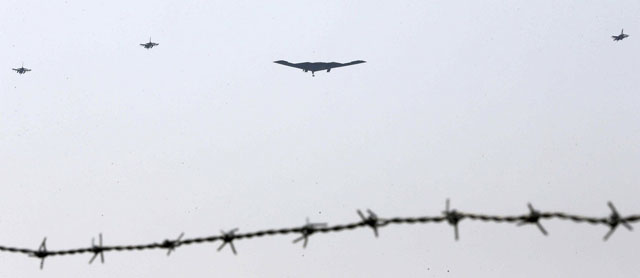
Nuclear-capable B2 “stealth” bomber over U.S.’ Osan air base, South Korea, March 28. Flights of B2,
B52 and F22 bombers in U.S./South Korean war “games” were clear threat to nuke North Korea.
(Photo: Shin Young-keun, Yonhap)
APRIL 13 – President Barack Obama is playing with fire, nuclear fire. Over the last month and a half, the United States and South Korea have engaged in an escalating series of military provocations against the Democratic People’s Republic of Korea (North Korea, or DPRK). Simultaneous “war games” have simulated a nuclear aerial bombing of the North, a ground invasion from the South, annihilation of the DPRK leadership (“decapitation”) and the “insertion” of tens of thousands of U.S. troops searching for nukes.
While the imperialist media are, as usual, strenuously demonizing the North Korean leader Kim Jong Un and playing up blustering statements coming out of the North Korean capital of Pyongyang, U.S. spokesmen feign a posture of level-headed calm, pooh-poohing war scenarios. In fact, however, the Pentagon has been laying the basis for a military strike against the North, to be billed as a “proportional response” to a DPRK “provocation.” Yet the actual provocations have come from the U.S. and South Korea.
The Internationalist Group and League for the Fourth International defend North Korea, a bureaucratically deformed workers state, against the war provocations, economic blockade and any attack by U.S. imperialism and its South Korean junior partners, no matter how it starts. We also defend North Korea’s development of nuclear weapons, its main deterrent against a war by the power which laid waste to the North in the Korean War, literally flattening every city and killing three million Koreans, and which today flaunts its ability to nuke the DPRK.
North Korea is universally portrayed in the West as a bellicose aggressor regime, threatening the U.S. and South Korea with thermonuclear war. Yet when Kim Jong Un orders strategic rockets of the Korean People’s Army (KPA) to be on “standby for fire so that they may strike any time the U.S. mainland, its military bases in the operational theaters in the Pacific, including Hawaii and Guam, and those in South Korea,” he is only vowing to do to the U.S. what the U.S.’ recent actions threaten to do the DPRK, and what every Korean knows it has done in the past.
The reality is that despite the bombast North Korea can’t and the United States can unleash thermonuclear destruction on a vast scale. But at what cost? That gives some in Washington pause, even as top officials including Obama adopt a hard-line stance on Pyongyang. North Korean missiles can’t hit the U.S., but KPA ground forces could indeed turn the South Korean capital of Seoul into a “sea of fire.” With its over-the-top statements, the DPRK is underlining that it is prepared to wage “the final do-or-die battle with the U.S.” if attacked (Korean Central News Agency, 11 April).
Obama declares himself an admirer of President Theodore Roosevelt, who coined the phrase “speak softly and carry a big stick.” These days, the U.S. commander in chief minds his words while brandishing a very big nuclear stick at the North Koreans, who respond by speaking loudly and waving the only stick they have. Pointing to other countries on the U.S. hit list who didn’t have nukes, the North Korean paper Rodong Sinmun (Workers Press) wrote: “Let the American imperialists know. We are not a pushover like Iraq or Libya” (New York Times, 16 March).
Meanwhile, the military and economic measures the U.S. has undertaken against the DPRK, in contrast to its guarded words, are quite aggressive and provocative.
Last December, when North Korea successfully launched a satellite into space, the U.S. called for intensifying economic sanctions against the DPRK, arguing that the satellite launch was the equivalent of an intercontinental ballistic missile test, which it had gotten the United Nations to ban. This was refuted by a National Research Council panel of top scientists and military experts that held that the technology and trajectory of the launch rocket differed from an ICBM and the small payload couldn’t possibly “be of any significant threat” (New York Times, 13 December 2012).
The stepped-up sanctions were voted at the United Nations on January 22. The DPRK delegate pointed out that there have been 2,000 nuclear tests and at least 9,000 satellite launchings since the U.N. was formed, yet none had been banned by the Security Council. When a week later South Korea lifted a satellite into orbit, there were no resolutions condemning that. North Korea expressed its defiance with a third nuclear test, on February 12, which was far larger than past blasts, and may have been based on uranium, of which the North has plenty.
The February nuclear test was met three weeks later with even more onerous U.N. sanctions intended to strangle the North Korean economy, this time aimed at bank transactions. But as in January, the most important aspect of the resolution was that the U.S. worked it out together with China, the DPRK’s main backer and trading partner. Since then there have been numerous stories in the Western press divining a qualitative shift in China’s backing for North Korea. But while Beijing may try to pressure Pyongyang, President Xi Jinping is certainly aware that the collapse of the DPRK would bring U.S. troops right up to China’s Yalu River border.
War “Games”: The
U.S. “Playbook” in Korea
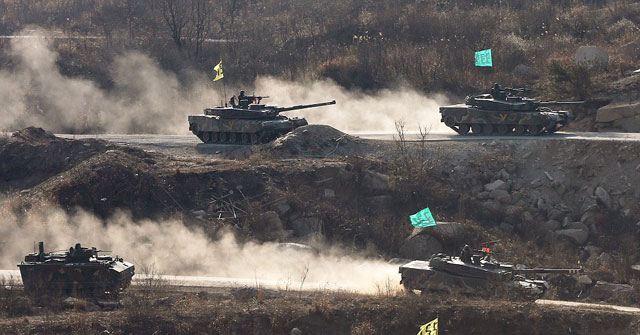
South Korean tanks (above) on maneuvers only 9 miles south of Demilitarized Zone in rehearsal of invasion of North Korea, March 27. South Korean marines (below) practice for landing in North Korea, March 28. (Photos: Yonhap, AP)
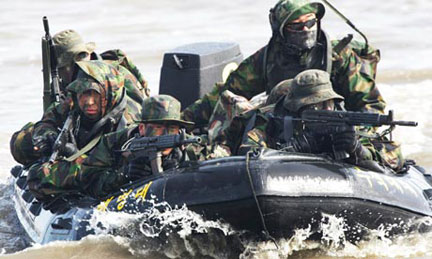 There is only
so much a tightened economic blockade
can do against North Korea, which is
already the most sanctioned country in
the world. So next came the
imperialist military provocations.
Beginning in early March, three
overlapping “war games” were launched
by the U.S. and South Korea. The
first, the annual two-month-long Foal
Eagle exercise, involves more than
10,000 American troops, along with
around 200,000 South Korean soldiers.
The maneuvers include a dress
rehearsal of a landing of tens of
thousands of troops to occupy
Pyongyang, and live-fire exercises
just below the armistice line of the
1950-53 Korean War.
There is only
so much a tightened economic blockade
can do against North Korea, which is
already the most sanctioned country in
the world. So next came the
imperialist military provocations.
Beginning in early March, three
overlapping “war games” were launched
by the U.S. and South Korea. The
first, the annual two-month-long Foal
Eagle exercise, involves more than
10,000 American troops, along with
around 200,000 South Korean soldiers.
The maneuvers include a dress
rehearsal of a landing of tens of
thousands of troops to occupy
Pyongyang, and live-fire exercises
just below the armistice line of the
1950-53 Korean War.
In the course of Foal Eagle, the U.S. flew nuclear-capable B-52 bombers from Guam and B-2 stealth bombers from Missouri on practice bombing runs off the South Korean shore. In addition, it flew in F-22 stealth fighter jets from Japan. This was the first time these aircraft had been used in these war maneuvers, and amounted to an unmistakable threat to nuke the North. It was in response to this that DPRK leader Kim Jong Un called an emergency meeting of senior generals and ordered rockets to be prepared to fire against U.S. and South Korean targets.
The second Pentagon “game,” Key Resolve, is a linked ten-day joint command exercise, this year for the first time led by the South Korean general staff. While the Pentagon claims they are defensive in nature, the clear purpose of these maneuvers is to practice for the annihilation of the North Korean military and leadership and occupation of the DPRK. This was underlined by the third “game” added this year. According to Defense News (26 March):
“The Unified Quest war game conducted this year by Army planners posited the collapse of a nuclear-armed, xenophobic, criminal family regime that had lorded over a closed society and inconveniently lost control over its nukes as it fell.”
The target was “the failed nuclear-armed state of ‘North Brownland’,” and “maps seen during the game at the Army War College — point to North Korea.”
According to the article, the exercise showed that, “while American forces in a neighboring friendly country to the south eventually made it over the border into North Brownland,” they encountered numerous difficulties. It concluded that it would take at least two months and 90,000 troops to pull off the invasion. Meanwhile, South Korea’s leading newspaper Dong-A Ilbo (7 March) reports that the U.S. has formed a special unit, including military intelligence forces, for entering North Korea, seizing nuclear facilities and arresting “key figures.”
And while the vast majority of the imperialist media, not just the sensationalist tabloids but also staid liberal publications like the New York Times and The Atlantic, are blaming mounting tensions on “North Korean provocations,” the Wall Street Journal (3 April) revealed that the escalation was part of “a step-by-step plan the Obama administration approved earlier this year, dubbed ‘the playbook,’ that laid out the sequence and publicity plans for U.S. shows of force during annual war games with South Korea.”
The playbook included the well-publicized flights by B-52, B-2 and F-22 warplanes, but supposedly “U.S. officials began to worry that the North, which has a small nuclear arsenal and an unpredictable leader, may be more provoked than the U.S. had intended,” according to the Journal, and that “the North, caught off guard, could do something rash,” whereupon the Pentagon “dialed back” its “Korean show of force.” But saying that “the White House has put the next steps in the playbook on hold” confirms that further steps are already scripted.
While “U.S. intelligence agencies…concluded there was a low probability of a North Korean military response because the regime’s top priority has been self-preservation” – thus belying all the Western propaganda about North Korean provocations – what if the DPRK leadership concludes that self-preservation requires a military response? A “slight miscalculation” and the Korean peninsula goes up in flames. Or was that the intention all along? In any case, the Journal account makes it clear who is stoking the fires – Washington.
But this is only the tip of the iceberg. Last October, the U.S. formally allowed South Korea to extend the range of its ballistic missiles to cover all of North Korea. That same month, Pentagon and South Korean military officials developed a plan for “tailored deterrence,” to meet any North Korean “provocation” (like a missile or bomb test) with disproportionate force, to “be applied in both peacetime and wartime,” according to a South Korean military official (see Gregory Elich, “What’s Annoying the North Koreans?” Counterpunch, 10 April).
This “tailored deterrence” plan includes a “kill chain” to take out KPA missile sites, and calls for preemptive attack, i.e., striking at North Korean missiles “before they are in position to employ,” according to the U.S. deputy commander of the U.N. Command Korea, Lt. General Jan-Marc Jouas.[1] More recently, the U.S. approved the sale to South Korea of “bunker buster” bombs, designed to hit North Korean underground command facilities. So while U.S. officials talk of “proportional response” to North Korean “provocations,” they are planning a first strike assault on the DPRK leadership and military, including in “peacetime.” Like now, for example.
Obama
Administration “Pivots” to Asia
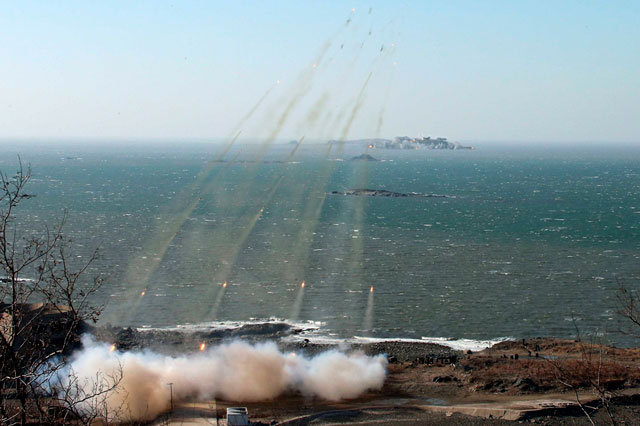
Missiles of the (North) Korean People's Army fired in drill practicing defense against landing from the
sea, March 14. (Photo: Korean Central News Agency)
Of course, this whole scenario is to be played out next door to China, the bureaucratically deformed workers state (with huge capitalist inroads) that the U.S. sees as the main challenger to its domination of East Asia. It’s all part of the “rebalancing,” or “pivot,” of U.S. strategic policy to the Asian-Pacific “theater” that Obama announced in October 2011. The purpose is to encircle and “contain” China, with U.S. bases in Japan, South Korea, Philippines and soon Australia. In fact, many of the recent American military moves are clearly directed against China, such as stationing anti-missile systems in Alaska and Guam and guided missile ships in the China Sea.
The current deliberate stoking of military tensions in the Korean peninsula is not the result of a megalomaniacal North Korean leader bent on attacking the United States, but of an aggressive U.S. imperialism throwing its weight around in East Asia in order to preserve global hegemony. Perhaps U.S. leaders seek to bully North Korea because they hesitate to attack Iran, despite pressure from Israel and its friends in the U.S. Congress. And there are some, such as the hawkish Center for Strategic and International Studies, who are chomping at the bit to launch a war that the Pentagon has been preparing to wage for six decades.
Bill Clinton went to the brink with North Korea in June 1994 as Pentagon chiefs considered a plan to bomb the nuclear reactor at Yongbyon, but ultimately backed off figuring it could set off all-out war on the peninsula. Six months later the U.S. negotiated the “Agreed Framework,” under which North Korea’s nuclear power plants (whose spent fuel could be reprocessed to produce create plutonium for a nuclear weapon) would be replaced by light water reactors. But Clinton soon reneged on the U.S. pledge not to threaten use of nuclear weapons, construction of the LWR power plant was endlessly delayed, fuel deliveries were stopped and finally in 2002 the Bush administration effectively canceled the agreement.[2]
North Korean then-president Kim Jong Il responded by asserting the DPRK’s right to possess whatever weapons it needed for self-defense and withdrawing from the Nuclear Non-Proliferation Treaty in 2003. Two years later North Korea announced it had built a “nuclear deterrent for self-defense,” and in 2006 it conducted a successful nuclear test. As recently as January 2013, Kim Jong Un appealed to “end the situation of confrontation between the North and the South,” and implement joint agreements signed in 2000 and 2007 known as the “sunshine policy” of economic cooperation. The response was the U.N. Security Council resolution tightening economic sanctions against the North.
Now the DPRK has written its nuclear deterrent into its constitution, declaring that it is not a bargaining chip subject to negotiation. It has restarted work on the Yongbyon reactor. It has declared an end to the armistice, announcing it is in a “state of war” with South Korea. And it has at least temporarily shut down the cross-border industrial park at Kaesong, making evident its willingness to forego billions in hard currency to underscore that it will not cave in to U.S. pressure. The deterrent value of nuclear arms is real. Even imperialist media have noted:
“North Korea’s arsenal of nuclear weapons, however small, has nonetheless emboldened it to challenge the United States and other nuclear-armed powers, which have responded with caution and – from North Korea’s vantage point – some degree of respect.”
–“North Korea Events Complicate Nuclear Talks with Iran,” New York Times, 6 April
The lesson has not been lost on Iran. We also defend the right of Iran to develop nuclear weapons in the face of U.S. imperialist and Israeli Zionist nuclear powers.
The imperialists’ ultimate intent is to reunify Korea on a capitalist basis, which would be a truly bloody affair. South Korea was for decades a de facto military dictatorship and U.S. protectorate. Even today its bourgeois “democracy” is strictly supervised by the military, which is still under the Pentagon’s thumb. The current president, Park Geun-hye, is the daughter of the dictator Park Chung-hee, who ran South Korea through torture and terror for more than a decade and a half (1963-78). Her administration is run by military brass, with no less than four former Army generals and three former Army chiefs of staff in key positions (Hankyoreh, 4 March).
Meanwhile, the South Korean economy is notoriously dominated by a handful of chaebol (Hyndai, Samsung, LG, SK) – military-connected, family-controlled conglomerates similar to the zaibatsu who ran the Japanese economy prior to World War II. Labor unions face heavy repression, including brutal police attacks on strikers and mass arrests of hundreds of workers. Top leaders of the Korean Confederation of Trade Unions (KCTU) have been jailed for months for leading strikes, both under right-wing regimes and under slightly liberal presidents who likewise implement the “free market” policies dictated by Washington and Wall Street.
As we have documented in several articles,[3] U.S. imperialism devastated North Korea during the Korean war, using napalm and mass murder to stave off the “communist threat,” and it has never stopped trying to conquer the North for capitalism. To justify its campaigns of military provocation and economic strangulation it rails against the DPRK for exercising its right to self-defense by building a nuclear deterrent. And to prepare the way for full-scale invasion, it is constantly predicting that the “rogue state” is on the brink of becoming a “collapsed state.” But despite more than half a century of unrelenting pressure, North Korea is still there.
Stalinist
Sycophants and Social-Democratic Lap
Dogs
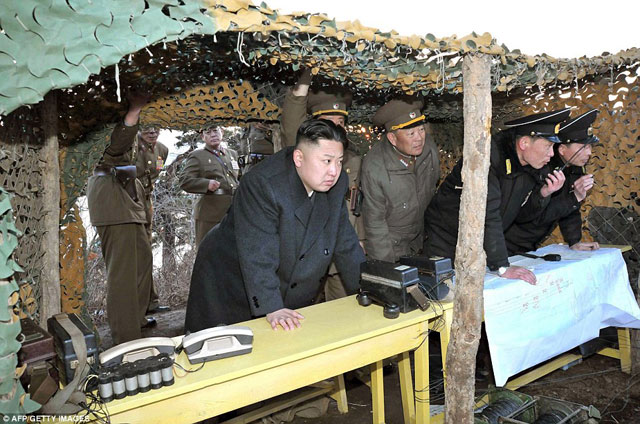
North Korean leader Kim Jong Un observes anti-landing drill together with KPA leaders, March 25.
(Photo: AFP)
The Democratic People’s Republic of Korea from the outset has been led by a narrow military clique wedded to the Stalinist-nationalist dogma of “building socialism in one country.” The governing dynasty (Kim Il Sung, then Kim Jong Il, now Kim Jong Un) runs a heavy-handed regime that would be quickly swept aside in a proletarian upheaval that establishes genuine workers (soviet) democracy. We denounce the bureaucracy that distorts and undermines the collectivized economy. But North Korea has overthrown capitalism, and despite its misleaders, that must be defended as part of the struggle to go forward to international socialist revolution.
As the history of capitalist restoration in the former Soviet Union and East Europe shows, the reconquest of the North by capitalist imperialism would be a defeat for the working class internationally and would further embolden the White House and Pentagon war machine.
Over Korea, the left in the capitalist and imperialist countries is today largely divided between Stalinist and Stalinoid apologists of the Kim regime and social-democratic toadies of imperialism. The former are exemplified by the Workers World Party (WWP) which hails “the determination of the DPRK leadership” and “the solidarity of the people through their party” (Workers World, 11 and 18 April). Following the Stalinist policy of seeking “peaceful coexistence” with imperialism, the WWP only calls to sign a peace treaty with the North rather than outright defending it. But this hasn’t stopped it from being viciously red-baited over North Korea in the “antiwar” movement by pro-Democratic Party reformists and liberals.
The social-democratic tendency among those claiming a radical pedigree has historically been represented by the current led by the late Tony Cliff, who broke from the Fourth International in 1950 refusing to defend North Korea in the war with U.S./U.N. and British imperialism (after earlier declaring the Soviet Union “state capitalist”). This heritage is today embodied by the Socialist Workers Party of Britain and the International Socialist Organization in the U.S. But the most disgusting current case of this pro-imperialist Stalinophobia is the Committee for a Workers International (CWI) led by Peter Taaffe, in an article titled: “North Korea: Dictator threatens nuclear attack” (9 April).
The CWI article argues that South Korea is a “major threat” to Kim Jong Un because of “its higher living standards and certain basic elements of democracy.” Now let’s see, would those “basic elements” include the mass arrest of striking unionists, for example in the Ssangyong Motor Co. strike of 2009? Or the eight supporters of the Cliffite tendency in South Korea who faced sentences of up to seven years under the notorious National Security Law of 1948? The article also breathed a sigh of relief that “the initial response of the US to North Korea’s threats” had “thankfully been ‘ratcheted down’.”
So for these social democrats the problem is North Korea’s threats, “thankfully” taken in stride by the level-headed imperialists. The Maoists used to denounce the “running dogs of imperialism” (that is until Mao joined forces with U.S. imperialist butcher Richard Nixon against the Vietnamese). But the imperialism-thanking, cop-loving CWI are nothing but lap dogs of “their own” imperialist rulers. Maybe they can write leaflets to be air-dropped by the U.S. Air Force over North Korea like another anti-Trotskyist renegade, Max Shachtman, did in the 1950s Korean War.
The League for the Fourth International has repeatedly demanded that all U.S. forces get out of Korea and called to abolish all U.S./U.N. sanctions on North Korea. While the U.S. would like to starve North Korea into submission and bring about the collapse of the DPRK with military provocation and possible attack, Trotskyists defend North Korea and fight for the revolutionary reunification of Korea, through socialist revolution in the South to bring down the chaebol and workers political revolution in the North to defend revolutionary gains and oust the parasitical bureaucratic caste that undermines them.
This is the perspective of authentic communists, who stand on the program of Lenin and Trotsky’s Bolsheviks and the 1917 Red October which heralded the world socialist revolution. It is no less relevant today with Korea teetering on the brink of thermonuclear war. ■
[1] See Gregory Elich, “Mapping the Future of the U.S.-South Korean Military Alliance,” Korea Policy Institute paper, 4 December 2012, for a detailed account of this ominous new strategic plan and what it portends.
[2] This history is recounted in our articles, “Defend North Korea Against Nuclear Blackmail and War Threats!” and “U.S. Tries to Starve North Korea Into Collapse,” in The Internationalist No. 15, January-February 2003.
[3]“U.S./South Korean provocations Could Ignite New Korean War,” “What Sank the Cheonan?” and “U.S. War on North Korea Never Ended,” The Internationalist No. 32, January-February 2011; “Defend North Korea Against U.S. War Threats and Sanctions,” The Internationalist No. 31, Summer 2010.
To contact the Internationalist Group and the League for the Fourth International, send e-mail to: internationalistgroup@msn.com